Getting a new dog is scary enough when it’s your first dog, but when you have an adult dog at home, it’s even more intimidating. What if your older dog should injure your puppy? Will your dog still love you if you get another dog?
Don’t worry. Another dog can be a great friend to your current dog, but it’s essential to take care in introducing a new puppy to your older dog. Here are 5 tips to set you up for success.
HighlightsSet specific areas for puppy’s activities to help both dogs adjust.Allow dogs to smell each other first in a neutral area to acclimate.First face-to-face meeting of dogs should be on neutral ground.Watch for signs of aggression or fear during initial interactions.Use your older dog as a role model to help train the new puppy.
The information provided herein is for informational purposes only. Please refer to ourdisclaimerfor more details..
Table of ContentsSet Ground Rules for New PuppiesDesignate Puppy AreasSet Food and Toy RulesPlaytime EtiquetteOffer Sniffing OpportunitiesMeet on Neutral GroundWatch for Negative ReactionsYour Dog is Your Puppy’s Best TeacherProblem-SolvingHow Do You Get an Older Dog to Accept a Puppy?How Long Does It Take for a Dog to Get Used to a New Puppy?What Do I Do If My Dog Doesn’t Like My New Puppy?How Do I Stop My Old Dog from Being Jealous of My New Puppy?
Set Ground Rules for New Puppies
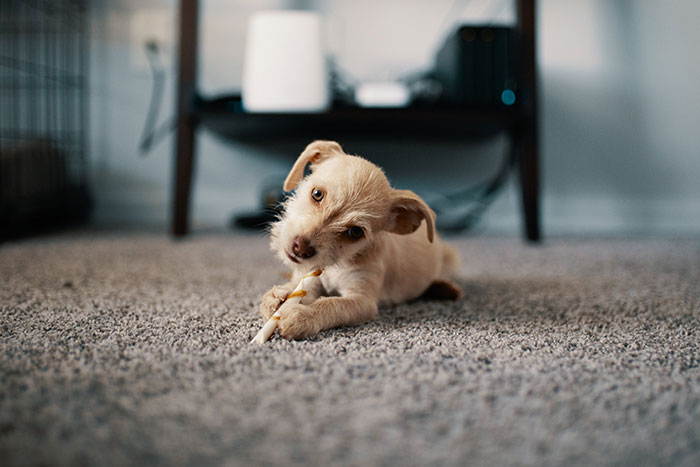
Image credit:Josh Sorenson
Preparing your home for the arrival of a puppy is more than setting up a sleeping area and play space. Establishing ground rules from the second puppy comes home sets the foundation for a healthy relationship between your dogs. Here’s what to cover in the rules for your new addition.
Designate Puppy Areas
Identify specific areas in your home for the puppy to eat, sleep, and play to create a structured environment for both dogs. If you plan to use a crate, begin crate training immediately.
Set Food and Toy Rules
One of the critical rules to establish right away is that the puppy is not allowed to take your other dog’s food or toys. This is crucial in preventing resource guarding and conflicts.
Each dog should have their own set of toys and separate feeding areas. They may be able to share as time passes but start with separate stuff at the beginning.
Playtime Etiquette
Teach your puppy that it’s not acceptable to jump on or bite your other dog unless they’re invited to play. Encourage gentle play and intervene when the puppy becomes too boisterous or bothers your older dog without being invited.
If you don’t teach your pup how to behave, your older dog will have to. They are likely to be severe and potentially harm the relationship or puppy.
Offer Sniffing Opportunities
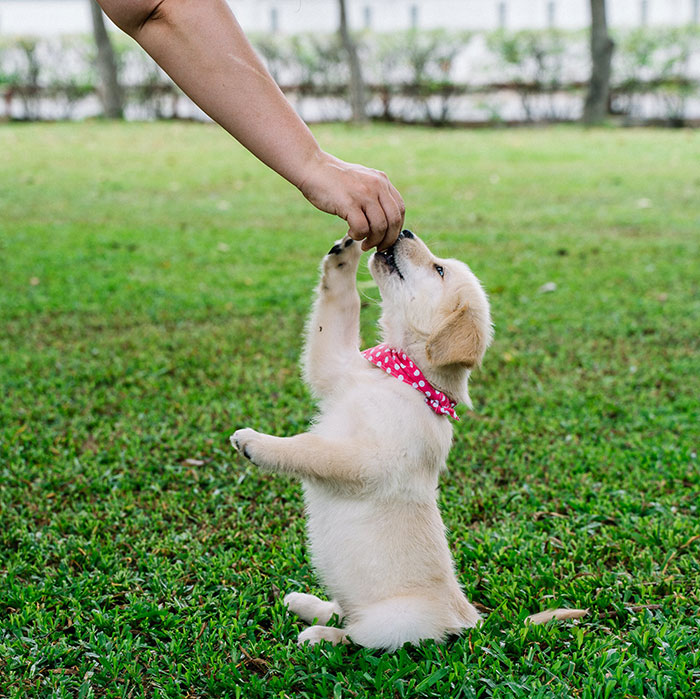
Image credit:Anna Tarazevich
Let the dogs smell each other before a direct visual encounter. This should be done in a neutral area, where both dogs feel less territorial. Use a visual barrier, such as a fence or a gate, where they can smell but not see each other.
This method allows each dog to become familiar with the other’s scent without the overstimulation of a face-to-face meeting. It also allows you to see how the dogs react to each other in a zero-stakes situation.
Meet on Neutral Ground
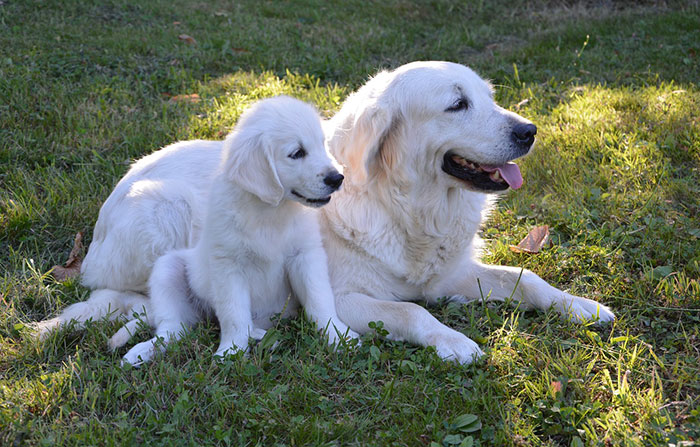
Image credit:JACLOU-DL
The first face-to-face meeting is a pivotal moment. Selecting neutral territory for this encounter is critical. A public park or an unfamiliar street makes territorial behavior in your existing dog less likely.
Before allowing the two dogs to meet directly, start with parallel walking. One person walks each dog, maintaining a safe distance between the two dogs.
Parallel walking is the next step after smelling to allow the dogs to become aware of each other’s presence without the pressure of direct interaction.
When it seems like both dogs are comfortable and exhibiting curious or calm behavior, you can gradually decrease the distance between them.
Watch for Negative Reactions
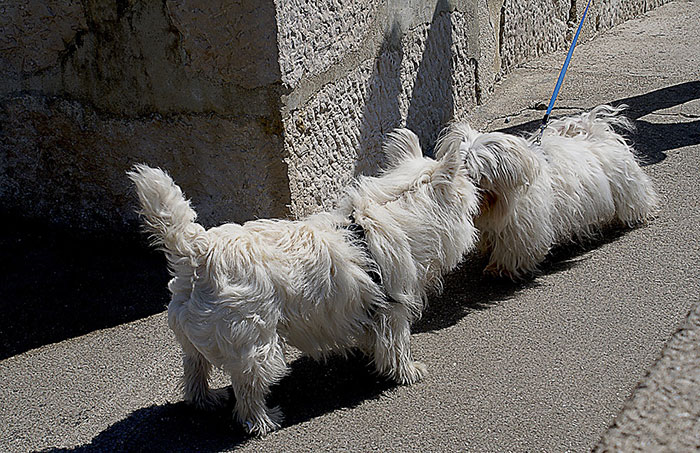
Image credit:pxhere.com
Observing both dogs’ body language and reactions during their initial meetings is crucial. If you’re not confident in dog body language, it’s a good idea to ask a trainer or other experienced dog handler to accompany you. Here are the basics of what to look out for:
Remember that reactions from both dogs, especially the puppy, may vary significantly throughout the interaction. Puppies are still learning social cues and might not always read or respond to the older dog’s signals correctly.
Managing Negative Reactions:
Your Dog is Your Puppy’s Best Teacher
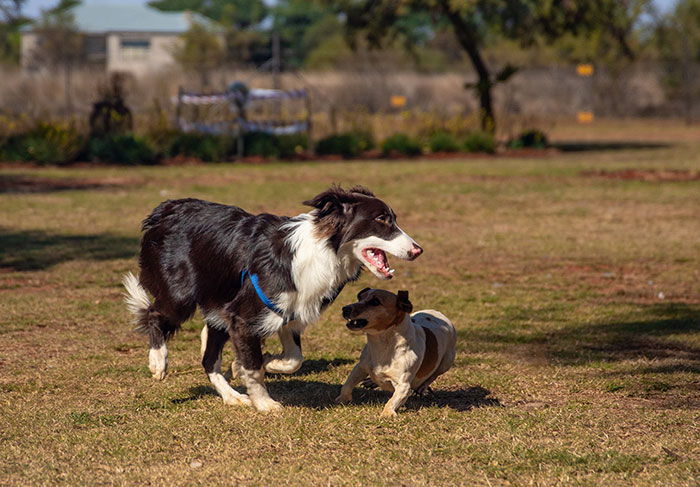
Image credit:Magda Ehlers
Puppies naturally look to older dogs for guidance and mimic their behaviors. Your senior dog is a key influence in their learning and socialization. Getting your dog to help will speed up the puppy’s training, as well as build the bond between your dogs.
Here are just a few ways your dog can help you train your pup:
Problem-Solving
How Do You Get an Older Dog to Accept a Puppy?
Positive reinforcement is key; reward the older dog and the new puppy for calm and friendly behavior. Keep initial interactions short and pleasant. It’s essential to give the dog already in the house plenty of attention and affection to reassure them of their place in the family.
How Long Does It Take for a Dog to Get Used to a New Puppy?
Some dogs react to a puppy as though you got it just for them, and it’s better than any toy you ever brought home. Some dogs give you that, “You’re dead to me.” look. That’s okay.
It’s normal for there to be some adjustment needed when a new dog enters the home territory of the old. Some may adjust within days (or even minutes), while others might take weeks or longer. Some dogs may never accept another dog in their home, although it’s uncommon.
Factors like the older dog’s temperament, past experiences, and the puppy’s behavior all play a role. Be patient and let them adjust at their own pace. Consistent, positive interactions will gradually help build a bond between them. If there is significant aggression even over weeks, it is wise to consult with a trainer.
What Do I Do If My Dog Doesn’t Like My New Puppy?
Don’t take aggression lightly. Dogs can and do seriously hurt puppies they don’t want in their home. Even if the older dog has always done well with other dogs–don’t risk it.
If issues persist, consider seeking advice from a professional trainer or a behaviorist.
How Do I Stop My Old Dog from Being Jealous of My New Puppy?
According toresearch, dogs display jealousy when they see their owner paying attention to another dog. Some dogs are very prone to jealousy, while others don’t seem to mind sharing their people at all. To prevent jealousy, it’s crucial to ensure your dog doesn’t lose anything due to this new dog in their life.
Make time to spend as much time with your old dog as you used to. Balance attention to give both dogs all the love, training, and exercise they need. Reinforce positive behavior from your older dog when they are calm or gentle around the new puppy.
328views328views
Pet Wellness